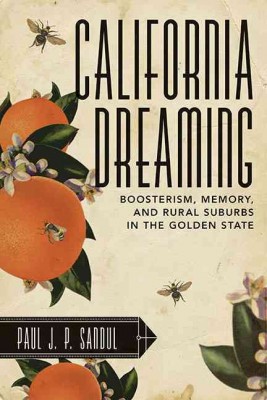| California Dreaming: Boosterism, Memory, and Rural Suburbs in the Golden State Contributor(s): Sandul, Paul J. P. (Author) |
|
 |
ISBN: 1938228863 ISBN-13: 9781938228865 Publisher: West Virginia University Press OUR PRICE: $26.09 Product Type: Paperback - Other Formats Published: October 2014 |
| Additional Information |
| BISAC Categories: - History | United States - State & Local - West (ak, Ca, Co, Hi, Id, Mt, Nv, Ut, Wy) - History | United States - 20th Century - Political Science | Propaganda |
| Dewey: 307.740 |
| LCCN: 2014025847 |
| Series: Rural Studies (Paperback) |
| Physical Information: 0.9" H x 6" W x 8.9" (1.15 lbs) 218 pages |
| Themes: - Chronological Period - 20th Century |
| Descriptions, Reviews, Etc. |
| Publisher Description: At the turn of the 20th century, the California dream was a suburban ideal where life on the farm was exceptional. Agrarian virtue existed alongside good roads, social clubs, cultural institutions, and business commerce. The California suburban dream was the ultimate symbol of progress and modernity. California Dreaming: Boosterism, Memory, and Rural Suburbs in the Golden State analyzes the growth, promotion, and agricultural colonization that fed this dream during the early 1900s. Through this analysis, Paul J. P. Sandul introduces a newly identified rural-suburban type: the agriburb, a rural suburb deliberately planned, developed, and promoted for profit. Sandul reconceptualizes California's growth during this time period, establishing the agriburb as a suburban phenomenon that occurred long before the booms of the 1920s and 1950s. Sandul's analysis contributes to a new suburban history that includes diverse constituencies and geographies and focuses on the production and construction of place and memory. Boosters purposefully "harvested" suburbs with an eye toward direct profit and metropolitan growth. State boosters boasted of unsurpassable idyllic communities while local boosters bragged of communities that represented the best of the best, both using narratives of place, class, race, lifestyle, and profit to avow images of the rural and suburban ideal. This suburban dream attracted people who desired a family home, nature, health, culture, refinement, and rural virtue. In the agriburb, a family could live on a small home grove while enjoying the perks of a progressive city. A home located within the landscape of natural California with access to urban amenities provided a good place to live and a way to gain revenue through farming. To uncover and dissect the agriburb, Sandul focuses on local histories from California's Central Valley and the Inland Empire of Southern California, including Ontario near Los Angeles and Orangevale and Fair Oaks outside Sacramento. His analysis closely operates between the intersections of history, anthropology, geography, sociology, and the rural and urban, while examining a metanarrative that exposes much about the nature and lasting influence of cultural memory and public history upon agriburban communities. |